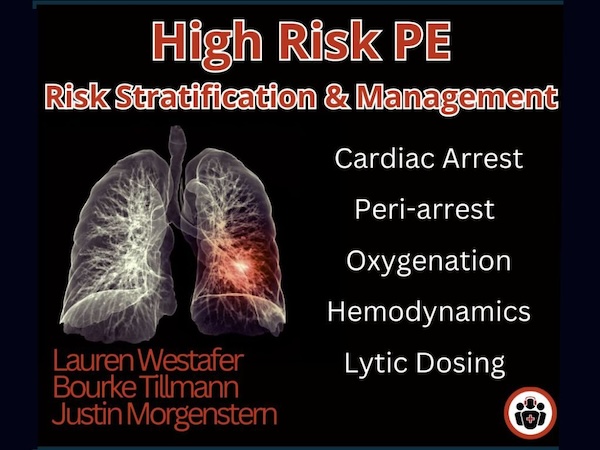View Transcript
Episode Description
Our patient from part 1 of this 2-part podcast series on pulmonary embolism management is now tanking. Recall she is a 30-year-old female on oral contraceptive pill who was satting 68% on room air when EMS picked her up after 6 hours of shortness of breath and a syncopal episode. She had an initial ECG and PoCUS suggestive of right heart strain, was started on IV heparin and had a saddle embolus on CTPA.
This time, however, instead of just being admitted to the ICU, she comes back from the donut of truth satting 88% on a non-rebreather with a blood pressure of 70/40 and now she’s altered. She now has a high-risk pulmonary embolism. How is this going to change our management?
These are the sickest of the PE patients – about 5-10% of all PE cases, but with a high mortality rate of 30-40% at 30 days. All of these patients, unless there are absolute contraindications, should be considered for timely thrombolysis, which is guideline recommended despite the evidence for mortality benefit being fair at best. Just like in intermediate-risk patients, high-risk PE patients are a heterogenous group ranging from the patient with persistent systolic BP under 90 and otherwise looking not bad, to the cardiac arrest patient. There are many nuances in the management of these patients in oxygenation and airway management, hemodynamic support, acid/base management, thrombolysis, catheter-directed therapies that we dive into with our guest experts Dr. Lauren Westafer, Dr. Bourke Tillmann and Dr. Justin Morgenstern...
Podcast production, sound design & editing by Anton Helman; Voice editing by Braedon Paul
Written Summary and blog post by Sara Brade, edited by Anton Helman May, 2025
Cite this podcast as: Helman, A. Morgenstern, J. Tillmann B. Westafer, L. High Risk Pulmonary Embolism Management. Emergency Medicine Cases. May, 2025 https://emergencymedicinecases.com/high-risk-pulmonary-embolism-management. Accessed August 14, 2025
Résumés EM CasesPart 1 of this 2-part podcast is on Intermediate Risk PE Risk Stratification and Management
How does PE kill our patients? The Pulmonary Embolism Spiral of Death
In pulmonary embolism, there is a physical obstruction (ie. clot) decreasing the flow from RV to LV. The RV is a weak muscle to begin with and this obstruction increases the pressure the RV has to pump against. As the RV starts to fail, it dilates and becomes even weaker resulting in hypotension. In an undifferentiated patient, we’re likely to start by giving them fluids. But the RV is very sensitive to fluids and as we give more fluids to a patient in this state, this causes the RV to dilate further. The RV then becomes ischemic and bows into the LV. The LV now can’t fill well because the RV is in the way and because there is limited flow coming from the pulmonary vessels. This worsens systemic hypotension. Further, vasoconstriction in areas of the lungs obstructed by clot causes hypoxemia, and hypoxemia worsens myocardial perfusion. This cycle is how our high risk pulmonary embolism patients die from if we don’t intervene.
Image soure: EMCrit : https://emcrit.org/pulmcrit/eight-pearls-for-the-crashing-patient-with-massive-pe/
Defining high-risk Pulmonary Embolism
High-risk pulmonary embolism, previously called massive PE, includes patients with hemodynamic instability due to PE delineated by one of the following:
* Cardiac arrest
This time, however, instead of just being admitted to the ICU, she comes back from the donut of truth satting 88% on a non-rebreather with a blood pressure of 70/40 and now she’s altered. She now has a high-risk pulmonary embolism. How is this going to change our management?
These are the sickest of the PE patients – about 5-10% of all PE cases, but with a high mortality rate of 30-40% at 30 days. All of these patients, unless there are absolute contraindications, should be considered for timely thrombolysis, which is guideline recommended despite the evidence for mortality benefit being fair at best. Just like in intermediate-risk patients, high-risk PE patients are a heterogenous group ranging from the patient with persistent systolic BP under 90 and otherwise looking not bad, to the cardiac arrest patient. There are many nuances in the management of these patients in oxygenation and airway management, hemodynamic support, acid/base management, thrombolysis, catheter-directed therapies that we dive into with our guest experts Dr. Lauren Westafer, Dr. Bourke Tillmann and Dr. Justin Morgenstern...
Podcast production, sound design & editing by Anton Helman; Voice editing by Braedon Paul
Written Summary and blog post by Sara Brade, edited by Anton Helman May, 2025
Cite this podcast as: Helman, A. Morgenstern, J. Tillmann B. Westafer, L. High Risk Pulmonary Embolism Management. Emergency Medicine Cases. May, 2025 https://emergencymedicinecases.com/high-risk-pulmonary-embolism-management. Accessed August 14, 2025
Résumés EM CasesPart 1 of this 2-part podcast is on Intermediate Risk PE Risk Stratification and Management
How does PE kill our patients? The Pulmonary Embolism Spiral of Death
In pulmonary embolism, there is a physical obstruction (ie. clot) decreasing the flow from RV to LV. The RV is a weak muscle to begin with and this obstruction increases the pressure the RV has to pump against. As the RV starts to fail, it dilates and becomes even weaker resulting in hypotension. In an undifferentiated patient, we’re likely to start by giving them fluids. But the RV is very sensitive to fluids and as we give more fluids to a patient in this state, this causes the RV to dilate further. The RV then becomes ischemic and bows into the LV. The LV now can’t fill well because the RV is in the way and because there is limited flow coming from the pulmonary vessels. This worsens systemic hypotension. Further, vasoconstriction in areas of the lungs obstructed by clot causes hypoxemia, and hypoxemia worsens myocardial perfusion. This cycle is how our high risk pulmonary embolism patients die from if we don’t intervene.
Image soure: EMCrit : https://emcrit.org/pulmcrit/eight-pearls-for-the-crashing-patient-with-massive-pe/
Defining high-risk Pulmonary Embolism
High-risk pulmonary embolism, previously called massive PE, includes patients with hemodynamic instability due to PE delineated by one of the following:
* Cardiac arrest
